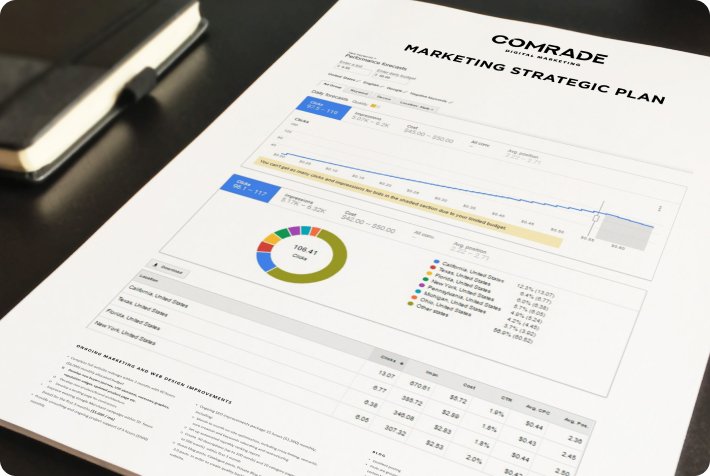
When creating a brand website, there are many moving parts behind the scenes that can help improve sales. Search engine optimization, or SEO for short, is a way to make your website more findable for users by improving your ranking on the search engine results page.
What Does It Mean for Your Website to Be SEO-Friendly?
Billions of individuals, likely including yourself, use search engines like Google on a daily basis. Think of the last time you searched for a good or service on Google. You likely don’t scroll through pages and pages to find a suitable choice. Instead, you likely browse through the top few options to find what you need.
The higher your website ranks on Google or other search engines, the higher the chances that a customer will find your company. The process of SEO involves Google crawling each website page and indexing it in its database to determine how websites should rank.
Google uses ranking factors such as security, mobile-friendliness, on-page optimizations, domain authority, page speed, links, social profiles, and so much more to help determine the hierarchy on the search engine results page, or SERP for short.
As you can imagine, SEO-friendly websites have a significantly higher chance of ranking well on Google which results in more traffic and more conversions.

Use SEMrush to determine an SEO-friendly website by analyzing organic visibility, auditing for SEO issues, evaluating backlinks, and comparing with competitors
At What Point Should SEO Be Considered?
Ideally, SEO is a factor that’s considered before your website is built. This approach can help you customize your site in a way that is SEO-friendly. Thus, you don’t have to back-track and make changes once your URL is live.
If you already have a functional website, don’t stress! There are plenty of tactics that you can weave into your digital marketing strategy to help improve your SSL and Google ranking. We will describe some helpful approaches below.
Delivering Business Results: Our Digital Marketing Case Studies
Increasing Your Chances of Google Crawling Your Website
1. Make Your URLs User-Friendly
User-friendly URLs are typically short, sweet, and easy to remember. Users may be able to remember your URLs off the top of their head if they’re concise, making it easier to drive traffic back to your site.
For example, if there’s a support page on your website, consider making the URL something along the lines of “www.[companyname]/support.” The more complicated text, symbols, and numbers in each URL, the more convoluted each becomes.
User-friendly URLs are also beneficial in your SEO strategy. Consider incorporating some pertinent keywords that tie into the context of the page. While it’s always beneficial to incorporate keywords into your URLs, be sure that doing so doesn’t make each one incredibly long.

A user-friendly URL is concise, descriptive, and easy to understand, helping users navigate a website effectively and improving search engine visibility
2. Create an XML Sitemap
A sitemap outlines how your website is organized and helps show Google what your most important pages are. XML sitemaps help search engines understand how your site is organized and provides a clear path on how to reach important content.
Strategic sitemaps can speed up the process of Google finding the most relevant information on your site, ultimately boosting your SEO ranking.

An XML sitemap is necessary as it helps search engines crawl and index website pages more efficiently, ensuring comprehensive inclusion and better visibility in search results
3. Block Search Indexing
In the case that you don’t have root access to your server and you want to control your site access one page at a time, you can block Google from indexing your site.
You can go about this one of two ways: putting a ‘noindex’ meta tag in the HTML code of the page that you want to block, or by returning a ‘no index’ header in the HTTP request.
When Google comes across a page and sees the tag or the header, it will completely drop the page from any search engine results pages.
4. Use Robots
Robots.txt are types of text files that are designed to crawl sites. These files indicate whether or not specific web-crawling software can crawl different areas of your website. Robots.txt isn’t a method of keeping a web page off of Google, rather, it communicates with search engine crawlers to let them know which page files they can or cannot request.
These files are typically used to oversee your site’s crawler traffic as well as to avoid overloading your site with too many requests simultaneously.
5. Focus on Internal Linking
Internal links help to connect multiple pages within the same website. These provide Google with an idea of how your site is structured and helps to establish a hierarchy on which pages are most important.
Comrade Digital Marketing Agency can help you with the above if you’re unsure how to go about it. Schedule a free consultation.
The Importance of High-Quality Content
Website content, just as you’re reading right now, plays a significant role in helping improve your SEO rankings. Without having a variety of quality content pages associated with your website, you provide Google with something to crawl.
Creating content such as service pages, blog posts, social media posts, infographics, videos, and many more can help increase engagement and prove your worth to your consumers. They are looking to you as a trusted source in the industry and well-written, factual content can bring them peace of mind that you are truly an expert.
In order to know what type of content to produce and what it should cover, you need to know what keywords and search terms your users are using. For example, if you had a camping equipment company, you may consider keywords such as “camping equipment near me.”
To be sure that you are tracking the right keywords, you’ll need to conduct keyword research. Keyword research is the process of finding the right relevant phrases to your business and utilizing them throughout your website in a strategic way to help Google find it.
Long-tail keywords are especially helpful for understanding how users search online, as they are three words or more. Because they are more specific, they can help improve your results and drive website traffic.
After selecting the phrases that you think are the most relevant to your business, you need to begin tracking them. This will help you determine if your approach is successful or if you need to slightly pivot to establish a better list of keywords.
Your keyword research should help determine the type of content to make. From infographics to blogs to ebooks, you can get creative and tap into new avenues to appeal to your consumer.
Read more about how to do keyword research in digital marketing.
6. Avoid Duplicate Content
Duplicate content occurs when there are large pieces of text that exist on other sites. Some duplicate content gets flagged for being nearly similar while other examples may be word-for-word the same.
This is a deceitful practice often implemented with the goal of gaining more website traffic. Search engines aren’t sure how to include or exclude pieces of duplicate content when creating query results, resulting in traffic loss.
To avoid duplicate content, consider the following tactics:
- Ensure all website copy is original and high-quality.
- Use 301s redirects (“RedirectPermanent”) to guide users and search engines to the right pages.
- Understand your CMS, or content management system, to understand how each piece of content is related to the next.
- Keep internal linking as consistent as possible.

7. Set Up Meta Tags
Meta tags are used to provide more information about a webpage and can be read by both Google and internet browsers. Information from meta tags is referred to as “metadata” and it can help Google better understand what your page is about.
Both title and description elements on your site are referred to as metadata.
For example, when you search “how to sew a face mask” on Google, you’ll see the following result on the first page of results:

Writing meta tags is necessary as they provide concise information to search engines and users, improving search visibility and click-through rates
“A Sewing Pattern for Fabric Face Mask – The New York Times” is the meta title and the explanatory information below is the meta description.
This description should be helpful to searchers and allow them to better understand the type of information you would see if you clicked on the full article. You only have about 150 characters for your meta description so do your best to pack a punch within that limit.
Having effective meta tags set up throughout your site can help earn your site more traffic and clicks.
8. Optimize Your Images
On average, images make up 21 percent of a webpage’s overall weight. Image optimization allows for your images to show up faster without hurting your website speed, helping to improve SEO.
Optimizing your images not only speeds up your site but helps improve your conversion rate and increase customer satisfaction.
9. Answer to Comments
Always do your due diligence to respond to customer interaction on your site and across your social media profiles. Doing so shows that you’re paying attention to your customers and doing what you can to improve their experience with your brand.
Make It Compatible for All Devices
Your work doesn’t end when the desktop version of your website is ready to launch. It’s important that you ensure that your site works seamlessly on a mobile device as well.
Consumers spend an average of 5 hours browsing the internet on their phones every day. Plus, over half of smartphone users have discovered a new brand or product while browsing their phones.

To ensure compatibility across devices, use responsive design, optimize images, prioritize readability and usability, and test on various browsers and devices
Your mobile website can help draw even more attention to your brand and reach a wide audience of consumers. Skimping on the mobile version of your website in turn gives your competitors a chance to capture the attention of these consumers.
Your mobile website should be simple and easy to navigate. It should also have fast loading times or your consumers may quickly become impatient and turn to a competitor. Don’t forget to make it easy for customers to contact you, after all, they are already on their phones.
Can I Ignore SEO When Running My Website?
Without focusing on SEO, your website likely won’t receive the traffic that you expect. In reality, SEO is likely a huge part of your competitors’ approach to their site and you’re making it easy for them to capitalize on your mistakes.
SEO is an integral digital marketing technique that is difficult to avoid if you’re trying to drive traffic and sales. The sooner you start focusing on creating an SEO-friendly website, the sooner you can begin reaping the benefits.
Learn how long it takes for SEO to work.
Conclusion
Making your site appeal to both search engines and potential customers is a no-brainer when setting up your website. SEO is an increasingly important factor in how well your website attracts new customers.
If you aren’t sure where to begin, consider turning to our team at Comrade Digital Marketing for assistance. Our work revolves around improving SEO results for our clients and we have the skillset and passion to help bring your company to new heights.
We’d love to chat more with you about your business and what we can do to help.
Frequently Asked Questions
How do I make my website SEO-friendly?
It's difficult to overrate the importance of creating an SEO-friendly website. Some of the most effective practices include making user-friendly URLs, writing authentic content, creating a sitemap, developing a profound internal linking structure, optimizing your images, and answering users' comments.
What are the steps to successful SEO?
There are 3 basic SEO steps to make sure your website successfully drives Google traffic. Firstly, please get to know your customers and their search habits. Whatever happens in SEO is predicated on the idea that you know who your prospects are. Secondly, optimize your website and add new content. And finally, maximize conversions from your website visitors.
Can I learn SEO by myself?
You can't get a college degree in SEO, so the only way to master it is to learn it yourself. Be aware, though, that SEO is difficult, and it takes a great amount of time and patience to get to the bottom of it. So if you need to market your website most effectively, and you can't spend months experimenting with various SEO practices, you'd better turn to a professional digital marketing agency.






